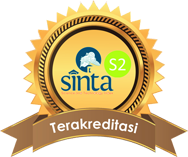ANALYSIS OF STUDENTS MENTAL MODELS THROUGH POE (PREDICT OBSERVE EXPLAIN) METHOD IN SALT HYDROLISIS TOPIC
DOI:
https://doi.org/10.15575/jtk.v5i1.5681Keywords:
mental model, POE, salt hydrolisisAbstract
This study aimed to analyze students mental models in salt hydrolysis topic using POE method (Predict Observe Explain) to determine students understanding of salt hydrolysis topic. The research method used descriptive qualitative approach. Data collection used diagnostic tests of mental models, observation, reflective journals and semi-structured interviews on samples of respondents of students class XI. The result showed that 3.88% of respondents had a Specific Misconceptions (SM) mental model, 7.9% Partially Correct (PC) and 88.146% Scientifically Correct (SC). It can be concluded that the majority of respondents have scientifically correct mental models and show themes which appeared at each macroscopic, symbolic and microscopic. Â
References
Abd Halim, N. D., Ali, M. B., Yahaya, N., & Said, M. N. H. M. (2013). Mental Model in Learning Chemical Bonding: A Preliminary Study. Procedia-Social and Behavioral Sciences, 97, 224-228.
Buckley, B. C., & Boulter, C. J. (2000). Investigating The Role of Representations and Expressed Models in Building Mental Models. Developing Models in Science Education, 119-135. Springer, Dordrecht.
Chang, R. (2005). Kimia Dasar Konsep-Konsep Inti. Jakarta: Erlangga.
Chermack, T. J., Song, J. H., Nimon, K., Choi, M., & Korte, R. F. (2012). The Development and Assessment of An Instrument for Measuring Mental Model Styles in Korea. Learning and Performance Quarterly, 1(1), 1-20.
Darmiyanti, W., Rahmawati, Y., Kurniadewi, F., & Ridwan, A. (2017). Analisis Model Mental Siswa dalam Penerapan Model Pembelajaran Learning Cycle 8E pada Materi Hidrolisis Garam. JRPK: Jurnal Riset Pendidikan Kimia, 7(1), 38-51.
Fazio, C., Battaglia, O. R., & Sperandeo-Mineo, R. M. (2017). Quantitative and Qualitative Analysis of The Mental Models Deployed by Undergraduate Students in Explaining Thermally Activated Phenomena. Scientia in educatione, 8.
Guba, E. G., & Lincoln, Y. S. (1989). Fourth generation evaluation. Newbury Park: Sage Publication.
Harrison, A. G., & Treagust, D. F. (2000). Learning about Atoms, Molecules, and Chemical Bonds: A Case Study of Multipleâ€model use in Grade 11 Chemistry. Science Education, 84(3), 352-381.
Johnstone, A. H. (1991). Why is Science Difficult to Learn? Things are Seldom what They Seem. Journal of Computer Assisted Learning, 7(2), 75-83.
Johnstone, A. H. (1993). The Development of Chemistry Teaching: A Changing Response to Shanging Demand. Journal of Chemical Education, 70(9), 701.
Murezhawati, E., Hairida & Melati, H.A. (2016). Peningkatan Keterampilan Proses Sains Siswa SMA dengan Model Pembelajaran Predict-Observe-Explain Materi Hidrolisis Garam. Jurnal Pendidikan dan Pembelajaran Khatulistiwa, 6(8).
Park, E. J., & Light, G. (2009). Identifying Atomic Structure as A Threshold Concept: Student Mental Models and Troublesomeness. International Journal of Science Education, 31(2), 233-258.
Sari, R. P., & Seprianto, S. (2018). Analisis Kemampuan Multipel Representasi Mahasiswa FKIP Kimia Universitas Samudra Semester II pada Materi Asam Basa dan Titrasi Asam Basa. Jurnal Pendidikan Sains Indonesia (Indonesian Journal of Science Education), 6(1), 55-62.
Sugiyono (2012). Metode Penelitian Pendidikan. Bandung: Alfabeta.
Suja, I. W., & Nurlita, F. (2016). Persepsi dan Model Mental Mahasiswa Tahun Pertama Terhadap Pembelajaran Kimia Organik di SMA. In Seminar Nasional Riset Inovatif, 4.
Treagust, D. F., & Chandrasegaran, A. L. (2007). The Taiwan National Science Concept Learning Study in An International Perspective. International Journal of Science Education, 29(4), 391-403.
Treagust, D.F. (2016). Sources Of Student Difficulties In Learning Chemistry.
White, R. T., & Gunstone, R. F. (1992). Probing understanding. New York: The Falmer Press.
Downloads
Published
How to Cite
Issue
Section
Citation Check
License
Authors who publish with this journal agree to the following terms:
- Authors retain copyright and grant the journal right of first publication with the work simultaneously licensed under a Creative Commons Attribution-ShareAlike that allows others to share the work with an acknowledgement of the work's authorship and initial publication in this journal.
- Authors are able to enter into separate, additional contractual arrangements for the non-exclusive distribution of the journal's published version of the work (e.g., post it to an institutional repository or publish it in a book), with an acknowledgement of its initial publication in this journal.
- Authors are permitted and encouraged to post their work online (e.g., in institutional repositories or on their website) prior to and during the submission process, as it can lead to productive exchanges, as well as earlier and greater citation of published work (See The Effect of Open Access).








